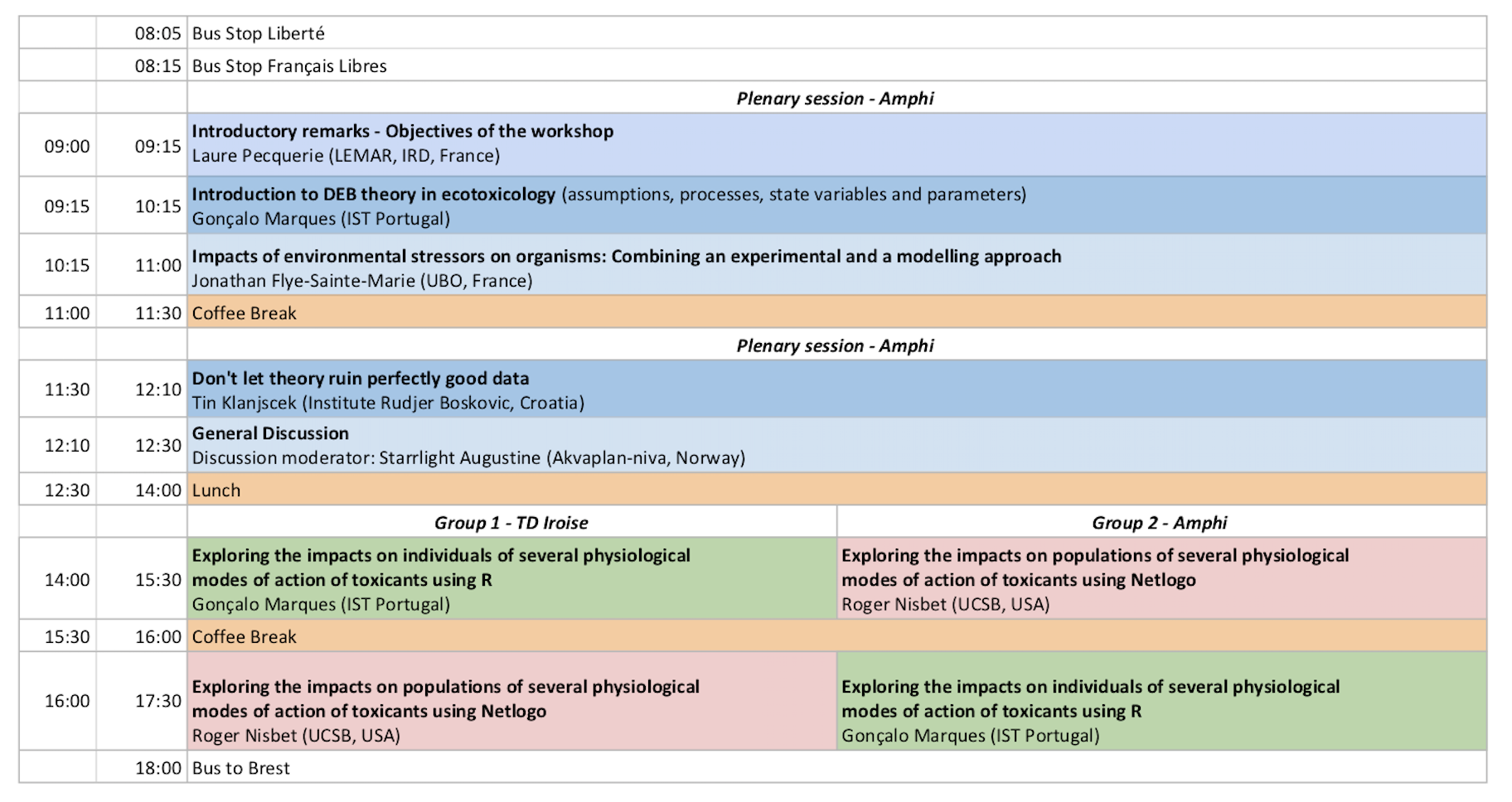
|
|
|
Workshop > Planning and content
Prior the DEB2019 Symposium, three workshops will be organized (free of charge but registration is required):
- Workshop 1: Biophysical ecology (April 8th)
- Workshop 2: Individuals to population (April 8th)
- Workshop 3: Environemental stressors, ecotoxicology and DEB theory (April 9th)
April 8 : Workshop 1 and 2: "Biophysical Ecology" and "Individuals to population"

Workshop 1 - Biophysical ecology: Mechanistic Niche Modelling with DEB, an introduction to NicheMapR
Michael Kearney - University of Melbourne, Australia
Sildes of the presentation of the exercice
Many of you will be interested in applying DEB theory to predict how species' life cycles unfold under different environmental conditions.
During the workshop we will show you how to use DEB theory within the NicheMapR package for mechanistic niche modelling in the R programming environment.
The first part introduces microclimate and heat budget (body temperature, activity time) modelling with NicheMapR.
The second part introduces some R scripts for running DEB simulations as well as running the full heat, water and metabolic budget with the NicheMapR ectotherm model.
Before the workshop, please download R and RStudio and the following zip 1 file and zip 2 file run the code provided in the first document under the "Installing NicheMapR and associated packages" section.
Workshop 2 - From individuals to population
Bob Kooi - The Netherlands
Individuals of one species living together is a region form a population. The population dynamics is described by the DEB model for each individual and their intraspecific and interspecific interactions. In the simples setting, of an unstructured population the state of the population is described by a single or a few entities such as total number or biomass. All individuals are treated the same and described by an ordinary differential equation. In the resulting model population properties emerge. For instant their extinction, invasion, growth but also equilibrium and its stability but also periodic in times solutions. The interaction with food is most important and the food availability can be time independent by also seasonally changing and changing autonomously in time.
On the other hand in structured models the properties of the DEB model individuals depend on age, structural volume, reserves energy and maturity. Mathematically this leads to a partial differential equation. The price for having a much more realistic model comes with a much more complication model. Both their analysis and numerical analysis is more evolved. Important is the modelling of fecundity, how energy in the reproduction buffer of the individuals is converted into offspring.
In the workshop we will discuss and analyse a model where individuals reproduce all at the same time and annually whereby the food is constant, changing periodically in time of is described by an unstructured population model (predator-prey type). The dynamics of a Torpedo marmorata population will be studied. The available Matlab code is partly from AmPtool with additional code for the implementation of the population properties.
Exercises require the Matlab software, please consider downloading a 30-day trial version (free) 30-day trial version (free) for the workshop, and the following zip file
April 9 : Workshop 3 : "Environemental stressors, ecotoxicology and DEB theory"

DEB theory provides a natural framework for dealing with environmental stressors and toxicity effects. In the afternoon, we will focus on how to model the effects of toxicants in an organism and some its effects at the population level with two different software, R and Netlogo.
Plenary session
- Introduction remarks Laure Pecquerie - IRD - Brest, France
- Introduction to DEB theory in ecotoxicology - Gonçalo Marques - IST - Lisbon, Portugal
- Impact of environmental stressors on organisms, combining experimental and modelling approaches - Jonathan Flye-Sainte-Marie, UBO, Brest, France
- Don't let theory ruin perfectly good data - Tin Klanjcek - IRB - Zagreb, Croatia
Exploring the impacts on individuals of several physiological modes of action of toxicants using R
Gonçalo M. Marques – MARETEC, IST, Universidade de Lisboa, Portugal
In the first part we will present what are the DEB Modes of Action (MoA) and how to technically implement the effect of a toxicant. We will also present paths on how to deal with mixtures.
In the second part we will use DEBecotox, an R package for predicting the impacts of single compound toxics or mixtures. We will go through the user-defined scripts that are needed to run the simulation. That includes the required packages DEBecotox and deSolve.
Exploring the impacts on populations of several physiological modes of action of toxicants using Netlogo
Roger Nisbet – UCSB, USA and Laure Pecquerie, IRD, France
Slides of the presentation of the exercice
This exercise is based on a paper by Martin et al (2014) (see also the appendix for the description of the model) who showed that knowing which pMoA(s) are impacted by a contaminant is of ecological importance because toxicity mediated by different pMoAs that lead to the same outcome in a standard reproduction test may have drastically different effects on populations when consumer-resource interactions are considered.
Before the workshop, please dowload the following zip file and install Netlogo (free).

